Manure

Manure is
Types

There are in the 21st century three main classes of manures used in soil management:
Animal manure

Most animal manure consists of feces. Common forms of animal manure include farmyard manure (FYM) or farm slurry (liquid manure).[1] FYM also contains plant material (often straw), which has been used as bedding for animals and has absorbed the feces and urine. Agricultural manure in liquid form, known as slurry, is produced by more intensive livestock rearing systems where concrete or slats are used, instead of straw bedding. Manure from different animals has different qualities and requires different application rates when used as fertilizer. For example horses, cattle, pigs, sheep, chickens, turkeys, rabbits, and guano from seabirds and bats all have different properties.[2] For instance, sheep manure is high in nitrogen and potash, while pig manure is relatively low in both. Horses mainly eat grass and a few weeds so horse manure can contain grass and weed seeds, as horses do not digest seeds the way that cattle do. Cattle manure is a good source of nitrogen as well as organic carbon.[3] Chicken litter, coming from a bird, is very concentrated in nitrogen and phosphate and is prized for both properties.[3][4]
Animal manures may be adulterated or contaminated with other animal products, such as
Compost

Compost is the decomposed remnants of organic materials. It is usually of plant origin, but often includes some animal dung or bedding.
Green manure
in the root structure.Other types of plant matter used as manure include the contents of the
.Uses
This section may require cleanup to meet Wikipedia's quality standards. The specific problem is: Focuses on the classical definition of animal manure. Reasonable as the use of other, expanded-definition "manures" is quite trivial, but the resultant lopsided structure may warrant a restructuring of the article. Or we can just hollow this out and merge to Feces#Uses of animal feces. (March 2022) |
Animal manure

Animal manure, such as
Odor is an obvious and major issue with animal manure. Components in swine manure include low molecular weight carboxylic acids,
Animal manures with a particularly
Manure is also commercially composted and bagged and sold as a soil amendment.[8][9]
In 2018, Austrian scientists offered a method of paper production from elephant and cow manure.[10]
Issues

Any quantity of animal manure may be a source of
In intensive agricultural land use, animal manure is often not used as targeted as mineral fertilizers, and thus, the nitrogen utilization efficiency is poor. Animal manure can become a problem in terms of excessive use in areas of intensive agriculture with high numbers of livestock and too little available farmland.[citation needed]
The greenhouse gas nitrous oxide can be emitted so contributing to climate change.[11]
Livestock antibiotics
In 2007, a
Organic foods may be much more or much less likely to contain antibiotics, depending on their sources and treatment of manure. For instance, by Soil Association Standard 4.7.38, most organic arable farmers either have their own supply of manure (which would, therefore, not normally contain drug residues) or else rely on green manure crops for the extra fertility (if any nonorganic manure is used by organic farmers, then it usually has to be rotted or composted to degrade any residues of drugs and eliminate any pathogenic bacteria—Standard 4.7.38, Soil Association organic farming standards). On the other hand, as found in the University of Minnesota study, the non-usage of artificial fertilizers, and resulting exclusive use of manure as fertilizer, by organic farmers can result in significantly greater accumulations of antibiotics in organic foods.[12]
See also
- Album graecum
- Anaerobic digestion
- Barn cleaner
- Biosolids
- Chicken manure
- Coprophilous fungi
- Cow dung
- Dry animal dung fuel
- Earthen manure storage
- Liquid manure
- Manure spreader
- Reuse of excreta
References
- ISBN 978-3527306732.
- ^ "Manure". h2g2. July 15, 2010. Retrieved 23 July 2017.
- ^ PMID 19119002.
- .
- PMID 28928727.
- PMID 22682363.
- ^ Thomas Bass, Julia Dafoe, and Joel Schumacher. "Manure Composting for Livestock & Poultry Production" (PDF). MontGuide. MT201206AG Reviewed 4/17.
{{cite journal}}: CS1 maint: multiple names: authors list (link) - ISSN 0002-1962.
- ^ "Using Manure in the Home Garden". Archived from the original on 2020-10-26. Retrieved 2019-07-06.
- Science Daily. March 21, 2018. Retrieved March 30, 2018.
- ^ "Managing manure to reduce greenhouse gas emissions". www.agric.wa.gov.au. Retrieved 2022-04-15.
- ^ a b Staff (2007-07-12). "Livestock Antibiotics Can End Up in Human Foods". ENS Newswire. Archived from the original on 2007-09-16. Retrieved 2012-11-14.
- PMID 17596632.
External links
- Application and environmental risks of livestock manure
- North American Manure Expo
- Cornell Manure Program
- County-Level Estimates of Nitrogen and Phosphorus from Animal Manure for the Conterminous United States, 2002 United States Geological Survey
- Manure Management, Water Quality Information Center, U.S. Department of Agriculture
- Livestock and Poultry Environmental Learning Center, an eXtension community of practice about animal manure management
- Antibiotics and Hormones in Animal Manure (Webcast): A two part webcast series about the science available on potential risks and best management practices related to antibiotics and hormones from animal manure
